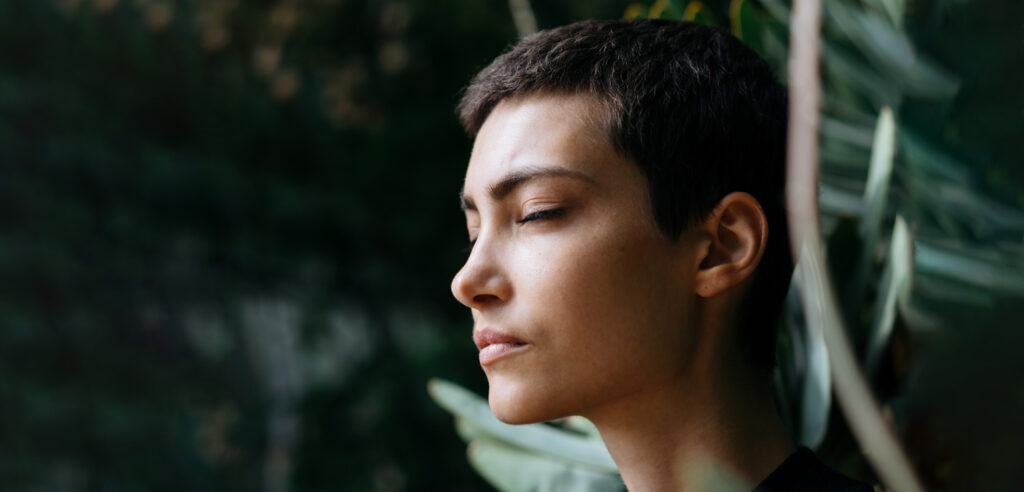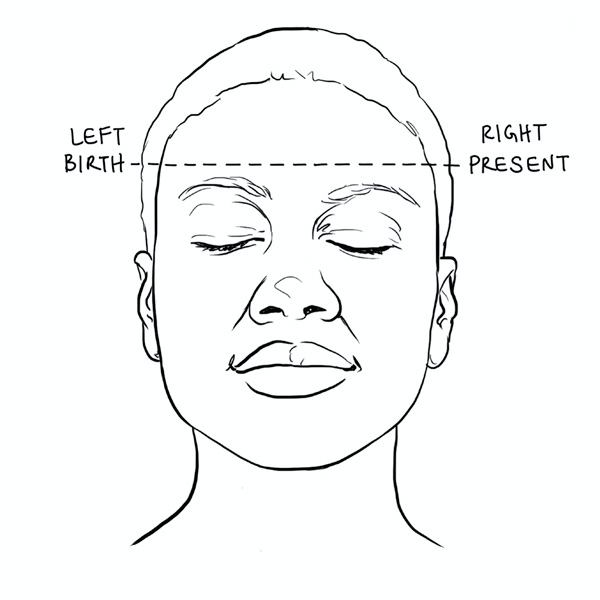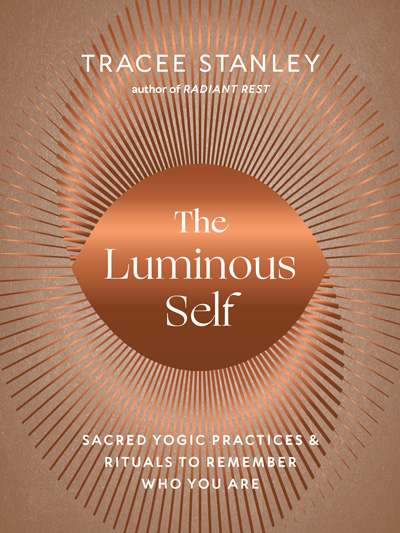
Estimated reading time: 14 minutes
An exploration of childhood trauma and a yogic practice for healing
—
How did I find myself in my bathroom naked, covered in egg yolk, banging on a drum, screaming and shouting at the top of my lungs? I had just cracked a raw egg over my head. And I had never felt so powerful and fierce. As I stared at myself in the mirror, I saw clarity and resolve in my eyes. I felt free. I knew I had released a power in me that was ancient.
Years of doing spiritual practices led me to this point of self-initiation that marked the moment I resolved to take back my power. It was a ritual, a reclaiming of a part of me that I had forgotten. The power of my deepest Self was waiting to be revealed, renewed, and nurtured.
The face looking back at me in the mirror wasn’t much different from that of the eleven-year-old who had stood in the junior high school bathroom in Huntington, New York, several decades earlier covered in broken eggshells, streaks of bright-yellow yolk dried against my dark brown skin. Three girls had just attacked me on the school bus. They didn’t like the way I wore my hair, the way I spoke, or the way I dressed. They didn’t like anything about me. And they had been diligent in making sure that I knew it every day of the school year.
From the first day I put on my first pair of thick eyeglasses in the third grade, I had been bullied.
I became used to the name-calling— “Olive Oyl,” “Four-Eyes,” “Ugly,” “Stick Figure”—but there was something different about these girls. They wanted to physically hurt me.
The day before what I’ll refer to as the “egg incident,” one of the girls watched me walk onto the school bus, turned toward me, and said loudly enough for everyone to hear, “Why do you wear your hair like that? It’s ugly!” She was mocking my natural hair that was awkwardly styled in an afro that had been locked in curlers the night before.
As I gathered my things to get off at my bus stop, there was a lot of whispering and snickering. I had a foreboding feeling in the pit in my stomach that something terrible was about to happen; they were planning to do something to me, and I heard a voice say, “Watch out for them.”
The next day I thought about trying to get out of going to school, but I knew I would only be putting off the inevitable. So I got myself ready. As I walked the half block to the bus stop, I felt like I was watching myself in a movie, getting ready to walk the plank. Every step was in slow motion and terrifying as I imagined what they might be planning. I wondered if this would be the “sticks and stones” that I had long feared.
As the bus arrived, the creaky doors opened like the mouth of a shark waiting to swallow me. I climbed the steps and noticed that the three girls who usually sat at the back of the bus were up front that day. They all smiled strangely at me, as if to say, It’s alright, don’t worry. But my nervous system knew better, and my heart began to race. I braced myself as I noticed the only open place to sit—one seat behind them. The whole bus seemed to be in on whatever was about to happen. Even my friends wouldn’t make eye contact.
Then it happened. They jumped me, attacking me—one from behind and the other two from the top, smashing raw eggs into my hair as they cackled and called me names.
No one on the bus did anything, not even the driver. I saw the driver look back, but he just kept going. I tried to protect myself from their blows to the head and face, hoping to keep my glasses from being broken. When I finally managed to kick the biggest girl off me, I hit her in the head. She looked surprised and then returned to her seat. It was over. I was covered in raw eggs, and they seemed satisfied with the job they had done.
When we arrived at school, I made my way to the nearest bathroom. There I was, one of the youngest seventh graders in the school, standing in the bathroom feeling humiliated and shamed. I had never experienced this kind of public embarrassment before. I still had to make it to my homeroom class. In my imagination, everyone in the entire school had now heard what had happened and was waiting to laugh at me in the big, circular lobby where they hung out before homeroom.
I needed a plan. At the time, my mother was studying Egyptology, and I had been reading her books on the subject. I decided that I would pretend I was Cleopatra, dressed in her finest jewels and robes. I cleaned as much of the egg off as I could; I walked out of the bathroom and down the hall toward my class. I held my head high, shoulders back and chest lifted, as if I was walking through my kingdom. I was Cleopatra. I kept my gaze forward, not looking at anyone. I could feel the stares and snickers, but I ignored them and managed to make it to my class.
During homeroom, I was called to the principal’s office. To my surprise, the bus driver had reported the incident, and the principal wanted to know which girls had jumped me. I wouldn’t tell. I needed to keep my mouth shut and not risk another attack for telling on them.
The egg incident changed me.
I started sitting in the back of the class. I stopped wearing my glasses, even though I couldn’t see the board to take notes. I started turning in my homework late or not doing it at all. I was dropped from Honors English and was barely passing French—my two favorite subjects. I gave up playing the clarinet and violin. I stopped being the little girl who loved to learn and excel in school. I was shrinking. And most disturbingly, I started obsessively pulling out my hair, an anxiety condition known as trichotillomania that was misdiagnosed as an infection of hair follicles. The misdiagnosis allowed me to hide my hair pulling for years.
The events of that day were traumatic and had a ripple effect throughout my life that I didn’t understand until I began to practice and study the teachings of yoga. Yoga began to slow me down enough to understand that my life decades later was very much being informed by the pain of the past. The egg incident created what is known in yogic teachings as a samskara, an impression or imprint.[1] Everything we experience in life creates an imprint; in the journey of remembering our true nature, this is a concept we should explore and understand.
A Yogic Practice for Healing
INTENTIONAL PAUSE: CONNECT TO YOUR BREATH
Take a moment of intentional pause. If it’s comfortable, close your eyes or soften your gaze. Place your hands on your belly. Welcome three deep belly breaths—in through your nose, out through your mouth with an audible sigh. Then receive three deep breaths in through your nose and out through your nose. Feel your belly rise and fall as you breathe in and out.
Maybe in your life you’ve had a moment like mine—a demarcation moment, when something shifted within you because of an impactful emotional experience. It could be a moment of great joy and pride or a moment of deep sadness, fear, or discomfort. Life is a ceaseless flow of impressions and sometimes they can be challenging to navigate. If you have experienced trauma, it may be helpful to discuss your insights and feelings with a trusted therapist as you explore the next practice.
SELF-REFLECTION PRACTICE: TIMELINE REWIND—TRACING THE IMPRESSIONS
(10 minutes)
We will begin this practice by exploring the remembrance of peacefulness as an impression. Practice this contemplation sitting up in your preferred meditation shape.
Close your eyes if that is available to you; if not, keep your eyes slightly open and lower your gaze to the floor. Begin by gently bringing awareness to your breath. Notice your breath as it enters your nostrils; be aware of the cool temperature of your breath. As your breath leaves your nostrils, notice your breath is warmer. Repeat for three breaths, aware of the flow and temperature of your breath with each inhale and exhale.
Feel your belly expanding as you inhale and contracting as you exhale. Allow your chest to become still. Sense that all of your breath moves into your belly as the chest becomes still. For ten breaths, continue to feel your navel rise and fall. Allow your breath to be effortless, smooth, and even—that is, inhalation and the exhalation of equal length. This is 1:1 ratio breathing. For example, inhale for four counts and exhale for four counts. Feel into the space your body occupies from the top of your head to the tips of your toes. Feel as though your whole body is breathing. (1 minute)
Be aware of the space around your body. Draw a circle of protective light around your body. Choose any light that feels most protective to you—for example, fire or moonlight. If it is helpful, you can request benevolent beings or guides to surround the circumference of this circle to bring an additional layer of protection and peace to your circle of energetic protection. (1 minute)
Bring your awareness back into the space inside your body and feel into the space inside your head. Imagine the inside of your head as empty space—no organ or bones, just empty blank space.[2]
Bring your attention to your right ear and feel as though you can draw a line from your right ear all the way to your left ear through the empty space of your head.
Feel and sense this line as a timeline of your life. Your right ear represents this present moment, and your left ear represents the moment you were born.
As you feel into this timeline, begin at the right ear, pausing to recall the most recent experience where you felt a sense of peace. Just let your mind quickly rest in that moment in time; see or sense a snapshot of where you were and what you were doing in this peaceful moment. Don’t get caught up in a story—just remember the moment. And then quickly move on from the right ear toward the left ear as you move backward on the timeline to the next profound moment of peace, again just experiencing a snapshot of this moment in time and continuing to move backward, touching all of the significant moments
Continue to move backward in time toward your left ear until you reach another significant moment. Go back as far as you can in time until you reach the first moment you felt profound peace. If at any time you begin to feel uncomfortable, pause the practice and ground yourself by going outside for a walk or lying on the ground for a few minutes doing deep belly breathing.
When you feel complete, please spend five minutes freewriting about what you remembered and how you feel. In freewriting, you write whatever comes to mind as quickly as you can, without attention to sentence structure or spelling. Do not disregard any memory as insignificant. If the memory entered your awareness, it’s meaningful.
When your writing feels complete, take a moment to notice if there was any recurring theme among the memories that popped up for you. Write it down.
As you traced your life back to reexperience moments that created impactful impressions of peace, you may have encountered a variety of emotions. You may find this exercise helpful to trace back other impressions like courage, joy, discomfort, fear, or inspiration. The first time I did this practice I traced back the impressions of shame throughout my life, and it was helpful for me to understand how samskaras have shaped me. It’s important to acknowledge the impact of tracing the impressions on our timeline. The emotions that arise may be surprising, and you may need a moment to reset; please take a moment to transition from the last exercise by shaking it out.
INTENTIONAL PAUSE: JIBBA JABBA—SHAKING IT OUT
(10 minutes)
Shaking is a practice that helps to regulate the nervous system. You may notice that your dog shakes to release tension or stress.[3] It is important for us to give ourselves space to release emotions, anxiety, and stuck energy. When we shake, we mimic the body’s innate response to discharge overwhelm in the nervous system.[4] When we add sound to accompany our movement, we give voice and physical expression to thoughts and feelings that can otherwise be difficult to name and release.
Set your timer for five minutes.
Find a comfortable position standing. You can also do this practice lying down or sitting in a chair if standing or walking is not accessible for you. Begin by slowing walking in a small circle, moving your arms as you move.
Next, begin to repeat “Jibba jabba!! Jibba jabba!!” over and over to represent all the thoughts, worries, and concerns of the mind. By using “jibba jabba,” we let go of the idea of connecting to a story and can begin allowing thoughts and emotions to be released and spaciousness to be created.
As you continue, get louder and louder with your jibba jabbas, beginning to shake your whole body as much as is available to you—especially the arms, hands, feet, and legs. Shake every part of your body that is possible to shake. If you can’t shake any part of the body, imagine the body shaking. Continue walking (or jogging) faster in your circle and shaking it out while repeating “Jibba jabba!! Jibba jabba!!”
After three minutes of shaking and jibba jabbas, pause and be silent. Lie down. Rest and notice your body lying on the floor. (2 minutes)
Let your breath settle back into your belly. Watch the rise and fall of your navel. (1 minute)
Devote a few minutes to freewriting.
“That which makes you fall is that which makes you rise.”
I first heard this wisdom from the tantric teacher Sally Kempton, and it immediately reminded me of a verse from Coleman Barks’s translation of the poem “Childhood Friends” by the thirteenth-century Persian poet Jalal al-Din Rumi:
“Don’t turn your head. Keep looking at the bandaged place. That’s where the light enters you.”[5]
What if we examined our wounded places with compassion and acceptance? Could we see how we were shaped by them? Our reaction to painful experiences is nuanced, and we should be careful not to judge ourselves or measure our experience against another person. We can be both strengthened by these experiences and feel stuck in place at the same time.
There were a few things that were set in motion the day of the egg incident. The feeling of “watching myself in a movie” as I walked onto the school bus was the first experience that I can recall of witness consciousness—the feeling of being a detached observer of my thoughts and feelings. I learned that I had a powerful intuition, even though it would take me years to learn to trust it.
One of the gifts of that day was that I learned how to be resilient, but I also became less trusting. I began to study martial arts, and by eighteen I had a purple mohawk and spent Sunday afternoons stagediving at the club CBGB. I was physically strong, and my outer appearance said, You better not mess with me. But was that the real me? Or was I just wearing a mask?
INTENTIONAL PAUSE: SELF-INQUIRY
Devote several minutes to answering the following inquiries:
- What gifts or seminal lessons have you received from challenging experiences in life? Do these lessons have an expansive or contracting expression?
- What past experiences and wounds are you ready to heal from?
- Can you trace a limiting belief that you currently hold to an impactful experience of the past?
Footnotes:
- Swami Veda Bharati, Yoga Sutras of Patanjali with the Exposition of Vyasa, Vol. 1, Samadhi-Pada (TK), 140.
- Not everyone is visual. When I invite you to “imagine,” you may also feel, sense, or trust.
- David Berceli, Neurogenic Tremors, TRE, accessed January 20, 2023.
- Inge Sengelmann, Shake, Sweat, Tremble and Cry: It’s a Bleeping Global Pandemic! Therapy Aid Coalition, accessed January 20, 2023.
- Jalal al-Din Rumi, “Childhood Friends,” in The Essential Rumi, trans. Coleman Barks, with John Moyne, A. J. Arberry, and Reynold Nichol- son (San Francisco: HarperSanFrancisco, 1995), 142.
[Excerpted from Chapter 1 of The Luminous Self: Sacred Yogic Practices and Rituals to Remember Who You Are by Tracee Stanley © 2023. Reprinted in arrangement with Shambhala Publications, Inc. Boulder, CO.]
You may also enjoy reading The Sacred Pause: The Art of Activating Healing Energy, by Travis Eliot

